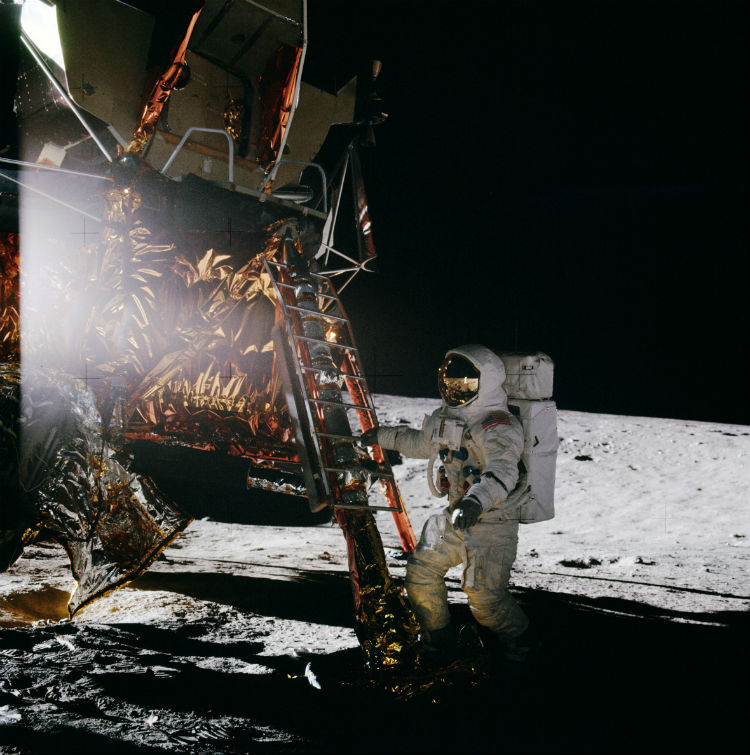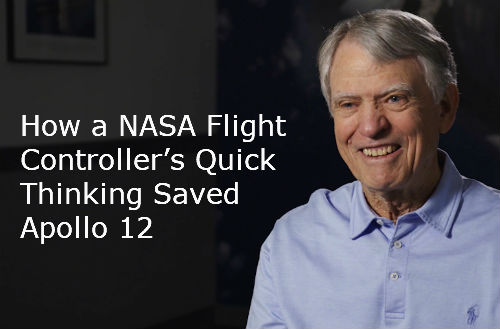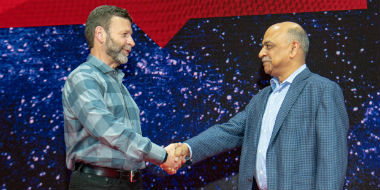Space Exploration
On Another Apollo Anniversary, a Reminder: IBM Space Technology Continues to Evolve
November 14, 2019 | Written by: Alexander Wolfe
Categorized: Innovation | Space Exploration | STEM
Share this post:

Apollo 12 Astronaut Alan Bean stepping off the Lunar Module, Nov. 19, 1969. (Photo: NASA; Scanner: Kipp Teague)
History’s publicists have done well by Apollo 11 and Neil Armstrong’s first moon steps in July 1969. However, fewer recall the Apollo 12 lunar mission four months later. It almost didn’t happen.
On Nov. 14, 1969, in the first minute after lift-off, two lightning bolts struck Apollo 12. The spacecraft’s main power supply went dark, cutting off the telemetry system – the vital communications link to mission control.
Thanks to the IBM guidance computer, the Saturn V rocket stayed on track. But the astronauts and NASA’s ground controllers were essentially flying blind, threatening the mission with an imminent abort. Only quick thinking by NASA flight controller John Aaron restored the telemetry link, allowing the Apollo 12 mission to continue.
Humankind’s goals for space programs have continually evolved in the half-century since Apollo 12. There would be five more Apollo missions, through the early 1970s. Then came the Space Shuttle program from 1981 to 2011 and the International Space Station, which has been in continuous operation since November 2000. Today, ambitious commercial space programs are underway.
Now, as in 1969, IBM is continuing to adapt the latest digital technologies to the challenges and opportunities beyond Earth’s gravitational pull.
A Wider Cast of Players
Back in the 1960s, putting humans into space was a U.S. government-led enterprise, with NASA running point and companies like IBM providing the technologies of the day to make it possible. Today, space is a broader endeavor. Yes, NASA plans to return to the moon by the end of the decade. But an expanding ecosystem of commercial space companies is attracting more of the headlines. Jeff Bezos’s Blue Origin is building a moon lander. And Elon Musk’s SpaceX is specifically aiming to deliver payloads to the moon and, subsequently, Mars.
All these efforts and others depend on key technologies from IBM. Already, for example, artificial intelligence (AI) is empowering robotic assistants like IBM’s Crew Interactive Mobile Companion (CIMON), which has helped astronauts on the International Space Station work in tight quarters.
Artificial intelligence also played a key role last year, when IBM was part of a NASA-led team that restored the ability of a powerful satellite to monitor the sun.
The satellite, NASA’s Solar Dynamics Observatory (SDO), launched in 2010, keeps a steady eye on the nuclear-fired Sun’s continuous wind of charged particles that stream toward Earth. Occasionally, the flurry of particles becomes powerful enough to damage satellites and electrical infrastructure on the ground – on rare occasion causing power failures. (The SDO is the same satellite that provided spectacular images of the planet Mercury’s recent transit across the face of the sun that was viewable from Earth.) In 2014, a malfunction on the SDO knocked out one of the instruments measuring the sun’s ultraviolet radiation.

The Solar Dynamics Observatory satellite, for which IBM has provided AI support, captured this image of Mercury’s transit across the sun, Nov. 11, 2019. (Photo: NASA’s Goddard Space Flight Center/Genna Duberstein)
NASA attempted to virtually re-create the lost data using a physics-based model, but this approach produced mixed results. But last year, the AI team on which IBM was a player, built a model that evolved as it learned from available ultraviolet radiation data, and figured out for itself how to best predict what is missing from the SDO’s readings. That model can re-create the missing measurements with a median error of only 2.25 percent: a drastic improvement over the physics-based model.
IBM’s blockchain technology will also have applications in space. Blockchain, for example, will be available to customers of a network of low-earth-orbit (LEO) satellites that Cloud Constellation Corp. plans to use to provide highly secure cloud data storage and global connectivity from space. Cloud Constellation has partnered with LeoStella to build the satellites. Blockchain may also eventually be used to verify the supply chain for manufacturing, launch and operation of such commercial space ventures.
“Everything today is being segmented — the launch provider, satellite manufacturer and the control station may all be separate entities,” said Naeem Altaf, IBM Distinguished Engineer & CTO Space Tech. “All of these different players are involved in sending one payload into space. With blockchain, we can bring them all together and have full transparency among them.”
Eventually, such networks of LEO satellites, which can remain in orbit for years at an altitude of 600 kilometers (about 373 miles) might function as full-fledged edge-computing data centers in space. Equipped with sensors and cameras, the satellites could also function as a spaceborne Internet of Things, observing every corner of the globe for uses like enhanced weather forecasting or providing pinpoint images for the rapid assessment of damage caused by earthquakes and tsunamis.
The Need for Secure Collaboration
The digital trajectory of the past half century began with moon missions equipped with less computing power than a modern smartphone. For the Apollo program, IBM essentially miniaturized an entire System/360 mainframe, packing its capabilities into 60-pound, suitcase-sized space guidance computers called Instrument Units. The IUs were installed atop the third stage of the Saturn V rocket that propelled Apollo 12 into space.
Today, space technology obviously brings much more computing power to bear than the highly constrained IUs of the Apollo era. And there are many more companies offering commercial space services than ever before. These days, the biggest challenge is no longer computation, but collaboration: How to manage and coordinate a large and growing ecosystem of space companies.
This is where IBM’s blockchain technology can have a big impact. A blockchain is an electronic ledger distributed across multiple machines in a way that the data can never be lost – or tampered with. Using blockchain means you have a trusted, secure record of everything that’s happened.
In partnering with IBM, Cloud Constellation plans to use blockchain in such a manner. The planned network of 10 satellites ringing the Earth is designed to provide secure data storage under the banner of SpaceBelt Data Security as a Service, DSaaS. The service is scheduled to begin in the first quarter of 2022.
The key to DSaaS’s security is that it bypasses terrestrial ground stations and the internet – and all their well-known vulnerabilities to intruders. DSaaS, purpose-built from scratch and verified by blockchain, is intended for sensitive data requiring robust security. When fully operable, it will have 1.6 petabytes of storage capacity.
The next logical step for such technology, IBM’s Altaf said, would be adding the ability to run applications, besides storing data – networks of orbital satellites that would function as full-fledged secure data centers in space. “It’s interesting to consider how we could leverage the compute capability that’s sitting on the satellites, enabling us to utilize them for edge computing,” he said. “The data is already there. So, bringing compute to where the data is – an edge data center in orbit – makes a lot of sense.”
Orbiting edge-data centers would be extremely secure, because they could likewise avoid terrestrial communications channels and receive uplinked data directly from a user.
AI in Support of Human Action
AI is another foundational technology for the continued evolution of space business, exploration and travel. Near term, AI’s biggest role could be data analysis and decision -making, given the potentially bewildering welter of data involved.
Making sure that astronauts have the knowledge they need at their fingertips is the task of one AI-infused robotic assistant that’s already taken flight. CIMON, the AI-powered Crew Interactive Mobile Companion, is a 5-kilogram spherical robot trained with
CIMON is the result of a partnership between Airbus, IBM and the German space agency, DLR. Airbus built CIMON, and IBM supplied its AI capabilities. Initially deployed on the International Space Station in 2018, CIMON returned to Earth this past August for upgrades to improve its comprehension of speech in specific contexts and ability to analyze emotion in language.
“The ISS is a huge place with many tight compartments where several astronauts often have to work together in close quarters,’’ Altaf said. “Plus, stuff is floating around everywhere because of the microgravity environment.”
CIMON is equipped with a camera that can detect objects and peer into tight spaces. It can also assimilate the many complex technical manuals astronauts need for their assigned tasks. “With Watson Assistant, if you’re looking for a certain error code, you don’t have to search for what it means,’’ Altaf said. “You can just ask CIMON, and IBM Watson Discovery has already indexed all the manuals.”
One day, the knowledge that CIMON makes readily available to astronauts might salvage a mission – much as John Aaron was able to quickly summon the esoteric expertise that saved the Apollo 12 mission. Whether back then, now or in spaceflights to come, “when an astronaut is diagnosing a problem,’’ Altaf said, “they need information quickly.”
Alex Wolfe is former Brand Director, EE Times, and Content Director, Design News.
_________________________________________
Related Stories:
- THINK Blog: How IBM Computers and a Flight Controller’s Quick Thinking Saved Apollo 12
- THINK Blog: The Apollo 11 Lessons We Live by Today
- THINK Blog: IBM & NASA Working Side-by-Side to Land on the Moon
- IBM News Room: Dr. John E. Kelly III and Apollo-era IBMers Discuss Moon Landing
- IBM News Room: IBM + Apollo 11: Stories, Images + Video
- THINK Blog: Watson Hops On Board Human Space Flight

Writer, IBM Content Hub
AI in 2020: From Experimentation to Adoption
AI has captured the imagination and attention of people globally. But in the business world, the rate of adoption of artificial intelligence has lagged behind the level of interest through 2019. Even though we hear that most business leaders believe AI provides a competitive advantage, up until recently, some industry watchers have pegged enterprise adoption […]
Q&A: IBM’s Landmark Acquisition of Red Hat
Arvind Krishna, Senior Vice President, IBM Cloud & Cognitive Software and Paul Cormier, Red Hat Executive Vice President and President, Products and Technologies discuss the landmark acquisition. How will IBM and Red Hat benefit from joining forces? Paul: Red Hat is an enterprise software company with an open source development model. A fundamental tenet […]
Nova Scotia Taps into Tomorrow’s Potential
The Government of Nova Scotia continually works to support the future potential of our students and help create opportunities for young people to see a future for themselves in our province. We are pleased to announce a new option for students through a unique IBM-inspired program that will provide more opportunity in the information technology […]


